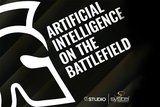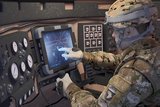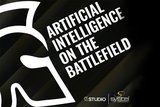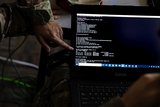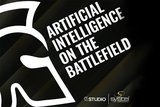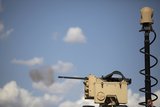Artificial intelligence becomes the critical enabler of future operations (Studio)
Brought to you in partnership with Systel
Artificial intelligence (AI) is widely recognised as a vital military capability that will only grow in importance in the era of multi-domain operations (MDO).
But what does this mean in practical terms, and how will the technology change the modern battlefield?
In the MDO concept – also known as Joint All-Domain Command and Control (JADC2) – platforms and systems across land, sea, air, space and cyber will interact and reinforce one another.
To make this possible, militaries will process and exploit vast reams of data, meaning that information processing and human-machine teaming will be essential. AI can provide vital advantages in all these areas, sifting through data at a rate far beyond any human operator.
When asked what brings the urgency to this space today, defence sources stress that there is little choice. Commercial technological innovations in AI have led to rapid, transformative changes across all service branches for all major powers.
Aneesh Kothari, vice president of marketing at Systel, a manufacturer of rugged computers, highlights that the US Department of Defense’s Third Offset Strategy, for instance, ‘holds that rapid advances in AI – along with robotics, autonomy, big data and increased collaboration with industry – will define the next generation of warfare’.
‘We are in the middle of an AI arms race, and the end goal is decision dominance on the battlefield,’ Kothari said, noting that the same impulses are driving US allies – and their adversaries.
AI enables operators to move past the limits of human capacity for mission-critical data-processing workloads. It reduces a significant degree of risk to personnel on the battlefield, such as the increasing ability to deploy uncrewed vehicles.
There is a wide range of programmes aiming to exploit such advances. One example is the UK Royal Air Force’s Nexus Combat Cloud, which allows data from any sensor on any platform in a given operating space to be processed in real-time. The service has also advanced a swarming drone capability through the “Alvina” programme.
The area has also naturally become a growing focus for industry. BAE Systems, for instance, has worked on AI in a range of areas, with some of this coming through Defense Advanced Research Project Agency (DARPA) programmes.
Such work includes MindfuL, software that can independently audit Machine Learning-based systems, helping build trust in the technology, which will be crucial as militaries boost their focus on human-machine teaming.
BAE Systems is also developing the Multi-domain Adaptive Request Service (MARS) for DARPA, which will enable semi-autonomous multi-domain mission planning.
Michael Miller, technical area director for BAE Systems FAST Labs, said that MARS significantly increases available resources, enabling battle managers to solve unforeseen requirements in a dynamic tactical environment rapidly. Crucially, the system empowers human operators, an essential element of AI’s practical utility on the battlefield.
‘The beauty of it is that it actually allows the human to make that final decision; it helps them find important capabilities and lets them decide which is the one they prefer,’ Miller explained.
AI and machine learning will help not just with data processing but also managing that data.
Fundamental to MDO or JADC2 is that in great power competition, communications will not be as assured as they once were – in fact, they will be under attack.
Data must be moved judiciously, while forward forces will be ‘dispersed, disaggregated and sometimes disconnected’, said Jim Wright, technical director for intelligence, surveillance and reconnaissance systems at Raytheon Intelligence & Space.
Against this backdrop, Raytheon is working on architectures in which cognitive agents manage the data flow, he said, considering the commander’s intent, how the battlefield is evolving, and the threats to communications, then using this information to determine how data should be placed.
Wright noted that AI/ML would support not just data processing, but ‘works itself into the management of data around the network’.

Nevertheless, the US and its allies don’t operate in isolation. As they develop their capabilities, so do potential rivals, most obviously China.
John Parachini, a senior international defence researcher at the RAND Corporation, pointed to several ways the country is applying the technology, including domestic security.
China is also making significant progress in applying AI to uncrewed vehicles, he noted. Likewise, Russia has made significant advances, particularly in the ground domain. However, the robotics must fit in with what a military force is trying to do and the environment in which it operates.
Other countries have also made substantial progress, including Israel and Turkey. It’s when the systems are used in the field ‘that you see the successes and failures … which is the real way that leapfrog advances are made’, Parachini said, pointing to the use of Turkish drones in Syria and other regions.
‘It’s those experiences that will provide the lessons learned that will allow them to improve their capabilities,’ he argued.
AI and humans have complementary strengths and weaknesses. While AI provides unrivalled data processing and management capabilities, humans can introduce a different perspective and intuition.
When these are combined, the result is an increasingly resilient capability. For example, Miller points to tools like Google Maps, which develop a new solution if a human deviates from a route.
Similarly, in defence applications, human intuition still matters, he said: ‘human understanding of intangibles, things that the algorithm itself can’t contemplate’.
Machines and humans have complementary strengths and weaknesses, Kothari noted. We must align these in the most productive way. While machines have exponentially faster abilities to crunch data, human intuition will remain critical for tactical decision making.
‘The human ability to see all the shades of grey, complemented by the machine’s ability to see black and white incredibly quickly and accurately, is a very powerful combination – and a winning combination for the nation that gets it right.’
More from The Artificial Intelligence on the Battlefield podcast
-
![Artificial intelligence and the human-machine interface (podcast)]()
Artificial intelligence and the human-machine interface (podcast)
The third episode of Shephard Studio’s Artificial Intelligence on the Battlefield podcast, sponsored by our partner Systel, looks more closely at the future of the human-machine interface.
-
![Putting the soldier at the centre of AI design (Studio)]()
Putting the soldier at the centre of AI design (Studio)
Militaries are turning to soldier-centred design to maximise the benefits of AI technology, placing humans at the centre of their development efforts.
-
![Artificial intelligence and multi-domain operations (podcast)]()
Artificial intelligence and multi-domain operations (podcast)
The second episode of Shephard Studio’s Artificial Intelligence on the Battlefield podcast, sponsored by our partner Systel, looks more closely at the military applications of AI.
-
![How is artificial intelligence changing the face of modern warfare? (Studio)]()
How is artificial intelligence changing the face of modern warfare? (Studio)
The promise and massive advantages of AI has led to doctrinal shifts and reimagining of systems and approaches for militaries around the world.
-
![Artificial intelligence and warfare - an introduction (podcast)]()
Artificial intelligence and warfare - an introduction (podcast)
Introducing Shephard Studio’s Artificial Intelligence on the Battlefield podcast, sponsored by our partner Systel.
-
![Systel launches Kite-Strike, a next-generation embedded edge supercomputer (sponsored video)]()
Systel launches Kite-Strike, a next-generation embedded edge supercomputer (sponsored video)
Watch how the next generation of combat vehicles will employ advanced AI algorithms to lower the burden on the human operator.












